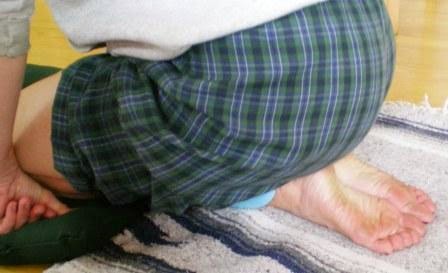Basic Foot Series
This series is designed to open up the joints and stretch the muscles of the lower leg and foot. This is a critical component of re-adjusting after being in ski boots or other footwear that is rough on the feet. It will also help to build the muscle of the lower leg and feet while improving resilience in order to absorb impact and support the rest of your body effectively.
Retraining and Building Awareness in the Lower Leg and Foot
Start by standing with feet together.
Re-position heels so that outside edges of feet are parallel.
Lift toes while pressing ball of the foot behind the big toe and also behind the small toes into the floor. Work at spreading all toes wide and lifting the arch from the bottom of the foot rather than from the top of the foot. This means do not use your ankle to move your arch further from the floor – it means use the muscles of your foot to actually contract your arch lifting it from the floor.
Widen stance to beyond shoulder width, keeping outside edges of feet parallel. Ankles will be bent to accommodate stance.
Place a cushion on the floor and kneel on the cushion. Prior to settling all the way to a sitting kneel, adjust the knees upward and place a rolled up blanket or yoga mat as far into the bend of the knees as possible. Settle back into a sitting position as far as possible, using a yoga block for support where needed. To ‘adjust knees upward’ simply reach below your knee cap and draw the skin of the knee back towards you – this will help to relieve some of the tension on the knee making the position more comfortable.
Hold onto a door for bracing and place the foot flat upon the door, bending knees and body as needed to make this possible.
Begin re-positioning body to a vertical position close to the door, allowing heel to move outward.
Begin toe traction by placing the weight of the heel of one foot onto the large toe of the other foot. Shift the body weight to the balls of both feet, allowing the back foot to raise the heel while keeping the big toe in place.
Opening the Forefoot, Aligning the Big Toe
Stretching Muscles, Tendons and Fascia From Ankle to Toes
Wrap or tie a yoga strap snugly around the ankles, then gently lower into a kneeling position on a cushion. Before settling, adjust knees upward then sit on heels with toes forward, flat on the floor. To ‘adjust knees upward’ simply reach below your knee cap and draw the skin of the knee back towards you – this will help to relieve some of the tension on the knee making the position more comfortable.
Repeat with feet and toes pointing directly backward so that the tops of the feet are on the floor. Support body weight with hands as necessary.
Lie backward onto the blanket, using a yoga block for a headrest if needed, allowing the upper legs to stretch and the chest to open up.
REST
It may be difficult to achieve benefit from these poses without knowledgeable help. Please feel free to contact me at any time should you require clarification. Please do not attempt any of these poses if they cause pain in anyway, As always, use common sense, this post, and all others on this site are not meant as medical advice.



















